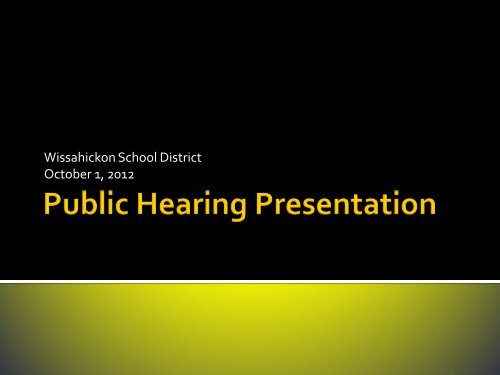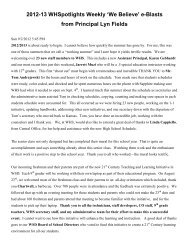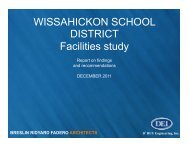Public Hearing Presentation - Wissahickon School District
Public Hearing Presentation - Wissahickon School District
Public Hearing Presentation - Wissahickon School District
Create successful ePaper yourself
Turn your PDF publications into a flip-book with our unique Google optimized e-Paper software.
<strong>Wissahickon</strong> <strong>School</strong> <strong>District</strong>October 1, 2012
“In the event of a permanent closing of a public schoolor substantially all of a schools facilities, the Board of<strong>School</strong> Directors shall hold a public hearing on thequestion not less than three months prior to thedecision of the board relating to the closing of aschool. Notice of the hearing shall be given in anewspaper of general circulation in the school districtat least fifteen (15) days prior to the date of suchhearing”.
“(a) The Board of <strong>School</strong> Directors of any schooldistrict may, on account of the small number of pupilsin attendance, or the condition of the then existingschool building, or for the purpose of bettergraduation and classification, or other reasons, closeany one or more of the public schools in the district…”
• Speakers will have up to 3 minutes each to sharecomments and information.• Speakers must be <strong>School</strong> <strong>District</strong> residents and/or<strong>District</strong> taxpayers – if time permits, other persons mayspeak.• We are using a numbering system, so please get anumber from the table at the middle tier of theauditorium.• Speakers will be called by number grouping and areasked to sit in reserved seating near a microphone.
• Ushers are located at each microphone to assistspeakers as needed.• Please begin your comments by stating your full nameand address and state if you are a resident or taxpayer inthe school district.• You may not allocate your time to someone else tospeak on your behalf.• A Spanish-speaking interpreter is available to assistpersons in providing public input.• Written comments may be submitted towcoleman@wsdweb.org on or before October 8, 2012.
• June 2012 – Administrative Recommendation Presented To<strong>Wissahickon</strong> Board of <strong>School</strong> Directors.• September 13, 2012 – <strong>Public</strong> notice in local newspapersregarding public hearing on possible school closure.• October 1, 2012 – First evening of hearing on possible schoolclosure.• October 8, 2012 – Second evening of hearing on possibleschool closure.• Three-month interim period.• January 14, 2013 – Anticipated public meeting of the<strong>Wissahickon</strong> Board of <strong>School</strong> Directors and vote on whether topermanently close Mattison Avenue Elementary <strong>School</strong>.
• Summer 2010:• Board of <strong>School</strong> Directors commissioned anenrollment study conducted by PA Economy League.• Spring 2011:• Board of <strong>School</strong> Directors commissioned a facilityfeasibility study conducted by D’Huy/Breslin.• June 2012:• Administrative Recommendations presented to theBoard of <strong>School</strong> Directors for consideration.
• Elementary Enrollment• Decreasing Population• Facility Feasibility• Capacity• Educational Framework• The Effect of Elementary Transitions• Elementary Grade Configurations• Size of <strong>School</strong>• Program Opportunity• Pre-Kindergarten Programming• Student Achievement Results• PSSA• MAP• Other Factors• Finance• Elementary Building Capacity
• Definition:• Transitions are defined by the number of times a student movesfrom one building to another.• Current Practice:• <strong>Wissahickon</strong> <strong>School</strong> <strong>District</strong> students experience transitionsfrom grades 5 to 6 and grades 8 to 9.• Mattison Avenue Elementary <strong>School</strong> students experiencetransitions from grades 3 to4, 5 to 6 and grades 8 to 9.
• Research Summary:• Transitions affect students academically, socially and/or emotionally.• When transitioning students from a lower achieving school, to ahigher achieving school, the overall performance of those studentsincreases.• Larger grade spans are better for students.• More transitions can negatively affect student achievement.• The more grade levels that a school services, the better the studentsperform.• Recommendation:• Standardize elementary student transitions to only grades 5 to 6.
• Definition:• Grade configuration is defined as to which grades are taught in aschool building.• Current Practice:• <strong>Wissahickon</strong> has 5 existing elementary schools. Four are in a K-5configuration and one is in a K-3 configuration that transitions into anexisting K-5 elementary school.
• Research Summary:• A K-5 Elementary building configuration is considered the standard.• 38% of elementary schools nationally have a K-5 configuration, followed by18% in a K-6 configuration.• 45% of elementary schools in Montgomery and Bucks Co. have a K-5configuration, followed by 32% in a K-6 configuration.• There are decreased opportunities for vertical curriculum alignment in schoolsthat are not in a K-5 configuration.• Student performance in K-5 elementary schools is better than performance inother grade configurations.• K-5 schools are fairly consistent in terms of achievement, whereas K-2/3schools score consistently lower in reading, mathematics and writing.• More opportunities are afforded for cross-age activities in larger grade spanschools.• Recommendation:• Establish that a K-5 elementary school grade configuration as the standard forthe elementary schools in the <strong>Wissahickon</strong> <strong>School</strong> <strong>District</strong>.
• Definition:• Is defined by the total student enrollment of the school building.• Current Practice:• <strong>Wissahickon</strong> <strong>School</strong> <strong>District</strong> has four K-5 elementary schools thatrange from 366 students to 496 students.• <strong>Wissahickon</strong> <strong>School</strong> <strong>District</strong> has one K-3 elementary school of 176students.
• Research Summary:• <strong>School</strong> size is not a valid indicator of success.• There is no correlation between school size and PSSA performance.• In Montgomery and Bucks Co., three of the elementary schools in the top5% PSSA scores for grade 5 were in buildings exceeding 800 students.• Improved focus on classroom instruction had the greatest impact onincreasing student achievement.• There is divided opinion among researchers related to the level of benefitto students provided by smaller learning environments.• Neighborhood schools, regardless of size, identified to be in urbansettings had a slight improvement in attendance and achievement.• Recommendation:• Balance elementary school enrollment using student enrollment analysisand available seat capacity.
• Definition:• Is defined as the ability to offer equitable access to facilities,resources, and personnel.• Current Practice:• <strong>Wissahickon</strong> <strong>School</strong> <strong>District</strong> offers equitable services for students in allfive elementary schools.• Restrictions based on scheduling and facilities needs exist at MattisonAvenue Elementary <strong>School</strong>.
• Research Summary:• Core and related academic services are limited in schools with shorter gradespans, i.e. K-2/K-3.• Shared resources limit the opportunities for professional collaboration.• Larger schools are better equipped to provide an expanded array ofopportunities for students.• Facilities in smaller schools are in most cases not equitable to the sameresources as their larger counterparts to provide increased programopportunities. i.e., multipurpose rooms, cafeteria, planning spaces.• Recommendation:• Advance the K-5 elementary school experience through greater distribution ofpersonnel and physical resources.
• Definition:• A child development/education program for children ages 3-5.• Current Practice:• <strong>Wissahickon</strong> offers full day Kindergarten. Program inception in theearly 1990’s.• <strong>Wissahickon</strong> is 1 of 12 Montgomery County <strong>School</strong> <strong>District</strong>s to offerfull day program as part of core elementary program.
• Research Summary:• Many different pre-school programs have been shown to producepositive effects on children’s learning and development, but thoseeffects vary in size and persistence by type of program.• No Pennsylvania public school district offers a locally funded pre-Kindergarten program.• Pre-K Counts and Early Intervention are the most beneficial programsavailable to qualifying students in Pennsylvania, as they are publiclyfunded options requiring no additional expense to local schooldistricts.• Recommendation:• Expansion of pre-Kindergarten programs are not recommended atthis time.
PSSA MathematicsClass of 2018Grade 3 2009 Grade 4 2010 Grade 5 2011 Grade 6 2012Adv Prof Bas Bel Adv Prof Bas Bel Adv Prof Bas Bel Adv Prof Bas BelMattison Avenue (N=32) 34% 44% 19% 3% 44% 44% 6% 6% 50% 25% 22% 3% 47% 41% 9% 3%Shady Grove (N=51) 63% 31% 4% 2% 82% 14% 0% 4% 69% 24% 8% 0% 67% 27% 4% 2%<strong>District</strong> (N=187) 64% 30% 5% 1% 83% 14% 2% 1% 84% 13% 3% 1% 84% 13% 3% 1%Grade 3 2010 Grade 4 2011 Grade 5 2012Class of 2019Adv Prof Bas Bel Adv Prof Bas Bel Adv Prof Bas BelMattison Avenue (N=25) 36% 48% 16% 0% 52% 32% 16% 0% 60% 20% 20% 0%Shady Grove (N=63) 71% 17% 6% 5% 76% 19% 2% 3% 67% 22% 8% 3%<strong>District</strong> (N=184) 65% 33% 1% 1% 85% 15% 0% 0% 82% 15% 2% 1%Grade 3 2011 Grade 4 2012Class of 2020Adv Prof Bas Bel Adv Prof Bas BelMattison Avenue (N=27) 15% 70% 11% 4% 37% 52% 11% 0%Shady Grove (N=75) 73% 21% 1% 4% 71% 24% 4% 1%<strong>District</strong> (N=198) 76% 20% 5% 0% 85% 13% 2% 1%Class of 2021Grade 3 2012Adv Prof Bas BelMattison Avenue (N=43) 33% 49% 9% 9%Shady Grove (N=64) 63% 31% 3% 3%<strong>District</strong> (N=219) 70% 22% 7% 1%Analysis of PSSA Math Data:• Beginning in Grade 3, an achievement gapexists between students in the MattisonAvenue cohorts as compared to their peers inthe other elementary cohorts.• As the Mattison Avenue cohorts transitionedinto the larger student setting in Grade 4,overall cohort students were able to maintainor make gains in their achievement.• As the cohorts progress through each gradelevel, the achievement of students in theShady Grove and other <strong>District</strong> elementarycohorts continues to be at a higher level thanthe Mattison Avenue cohorts.
PSSA ReadingGrade 3 2009 Grade 4 2010 Grade 5 2011 Grade 6 2012Class of 2018Adv Prof Bas Bel Adv Prof Bas Bel Adv Prof Bas Bel Adv Prof Bas BelMattison Avenue (N=32) 19% 63% 6% 13% 31% 47% 16% 6% 16% 59% 22% 3% 34% 44% 22% 0%Shady Grove (N=51) 43% 45% 4% 8% 63% 29% 4% 4% 35% 47% 14% 4% 57% 37% 2% 4%<strong>District</strong> (N=187) 40% 52% 5% 3% 60% 32% 6% 2% 36% 51% 9% 4% 63% 27% 7% 2%Grade 3 2010 Grade 4 2011 Grade 5 2012Class of 2019Adv Prof Bas Bel Adv Prof Bas Bel Adv Prof Bas BelMattison Avenue (N=25) 24% 64% 8% 4% 36% 52% 12% 0% 32% 36% 28% 4%Shady Grove (N=62) 50% 40% 6% 3% 60% 32% 6% 2% 53% 35% 8% 3%<strong>District</strong> (N=182) 46% 46% 5% 3% 63% 33% 3% 1% 46% 42% 9% 3%Grade 3 2011 Grade 4 2012Class of 2020Adv Prof Bas Bel Adv Prof Bas BelMattison Avenue (N=27) 19% 56% 11% 15% 30% 59% 11% 0%Shady Grove (N=75) 48% 45% 4% 3% 51% 39% 11% 0%<strong>District</strong> (N=198) 50% 43% 4% 3% 62% 32% 5% 1%Class of 2021Grade 3 2012Adv Prof Bas BelMattison Avenue (N=43) 30% 44% 5% 21%Shady Grove (N=64) 41% 52% 3% 5%<strong>District</strong> (N=218) 43% 45% 6% 5%Analysis of PSSA Reading Data:• Beginning in Grade 3, an achievement gapexists between students in the Mattison Avenuecohorts as compared to their peers in the otherelementary cohorts.• As the Mattison Avenue cohorts transitionedinto the larger student setting in Grade 4,overall cohort students were able to maintain ormake gains in their achievement.• As the cohorts progress through each gradelevel, the achievement of students in the ShadyGrove and other <strong>District</strong> elementary cohortscontinues to be at a higher level than theMattison Avenue cohorts.
MAP MathematicsMean RIT Scores:Class of 2020MAP ReadingMean RIT Scores:Class of 2020Mean RIT ScoresSpring 2011 Spring 2012Blue Bell (N=58) 216.4 221.7Lower Gwynedd (N=81) 216.3 229.1Mattison Avenue (N=26) 205.2 213.6Shady Grove (N=71) 213.8 221.7Stony Creek (N=56) 219.1 229.8Mean RIT ScoresSpring 2011 Spring 2012Blue Bell (N=59) 210.4 214.3Lower Gwynedd (N=80) 206 215.4Mattison Avenue (N=26) 200.6 209.3Shady Grove (N=69) 206.8 213.3Stony Creek (N=56) 209.8 217.2Analysis of MAP DataClass of 2020:• Similar to the trendsexhibited in Grades 1, 2,and 3, the MattisonAvenue cohort enters andconcludes Grade 4 withlower RIT scores than theother four elementaryschool cohorts.MAP LanguageMean RIT Scores:Class of 2020Mean RIT ScoresSpring 2011 Spring 2012Blue Bell (N=59) 209.1 215Lower Gwynedd (N=80) 205.9 215.3Mattison Avenue (N=26) 199.1 206Shady Grove (N=71) 205.3 212.2Stony Creek (N=56) 210.7 215.8
• Staffing• Reduced staffing costs would yield approximately $800,000.• Facilities• Reduced facility costs would be approximately $97,000.• Transportation• If two additional buses were needed, transportation costs would approximately increase by $45,000.• Capital Needs• Maintenance projects and improvements totaling approximately $3,400,000.▪ Replacement of food service equipment▪ Improvements to boys and girls bathrooms▪ Installation of an elevator▪ Casework replacement▪ Window and door replacements• Full renovation approximately $7,000,000.• Estimated Property Value• Conducted by Indian Valley Appraisal Company• Estimated value of $1,890,000.
9/26/12BB: 425LG: 487MA: 176SG: 496SC: 3669/26/12BB: 69LG: 98MA: 42SG: 166SC: 82
















